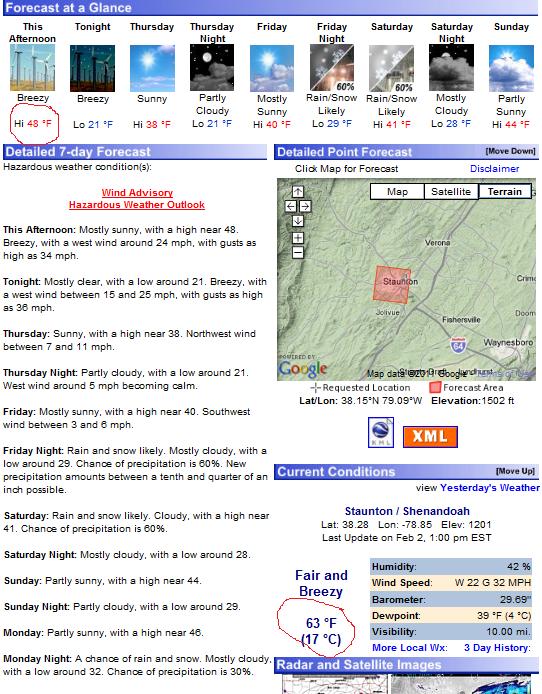|
Powered by WordPress
|
Wednesday: February 2, 2011
This was the official National Weather Service report for my house an hour or so ago:

The expected high for the day (upper left) is 48o, while the current temperature (bottom center) is 63o. I’ve complained about this sort of thing before (here and here), but I don’t believe I’ve seen a 15o discrepancy before.
Hmmm. Now that I’ve read my previous complaints, I see that they include a 14-degree discrepancy, so I should probably delete this post. However, I don’t have anything else to do today – home sick with strep throat – and I can’t resist letting victims of the massive blizzard know that here in the Shenandoah Valley it’s a beautiful spring day.
Maybe they should start reporting temperatures in Celsius, to keep the errors down to single digits. Or maybe they should just add two lines to their computer program, resetting the expected high to be greater than or equal to the current temperature, and mutandis mutandis with the lows.
Wednesday: December 29, 2010
The Rat is disappointed by a recent science article about drugs and alcohol in the (wild) animal kingdom: “How can you write about porcupines ingesting a hallucinogenic substance and not include a photo of same?!” Surely a YouTube video of a hopped-up porcupine would be infinitely better? The ubiquity of Flip cameras and such makes that a very reasonable request: this isn’t the ’50s.
Saturday: June 6, 2009
An English English professor — I mean an Englishman who is also a professor of English — mocks the hard sciences to a mathematician:
A great poet is always timely. A great philosopher is an urgent need. There’s no rush for Isaac Newton. We were quite happy with Aristotle’s cosmos. Personally, I preferred it. Fifty-five crystal spheres geared to God’s crankshaft is my idea of a satisfying universe. I can’t think of anything more trivial than the speed of light. Quarks, quasars — big bangs, black holes — who gives a shit? How did you people con us out of all that status? All that money? And why are you so pleased with yourselves?
. . . . . . . . . . . . . . . .
I’d push the lot of you over a cliff myself. Except the one in the wheelchair, I think I’d lose the sympathy vote before people had time to think it through.
(Tom Stoppard, Arcadia, Scene 5)
Wednesday: January 28, 2009
Until I sat down today to compile a review worksheet on Latin prepositions, I had never noticed an inconsistency or inconcinnity in the names of the parts of the electromagnetic spectrum. If non-visible frequencies of light are seen as metaphorically going beyond or falling short of the visible spectrum, the opposite of ‘ultraviolet’ should be ‘citrared’. On the other hand, if they are seen as metaphorically placed above or below the visible spectrum, the opposite of ‘infrared’ should be ‘suprared’. I wonder if other languages are more logical or (if you like) more pedantically Latinate.
Which reminds me: when I first saw the word ‘infrared’ in (I suppose) 5th or 6th grade, I thought it was a disyllable, the perfect passive participle of a verb infrare* that I had somehow never run across before. I wonder if that is a common misapprehension.
And speaking of illogic: why does the spell-checker tell me to write ‘pedantically’ rather than ‘pedanticly’? There’s no such word as ‘pedantical’. I suppose I could research this, but I have more worksheets to put together before I go to bed. I would have thought that two Snow Days in a row would be enough to catch up on my work and my blogging, but apparently not.
Monday: January 5, 2009
I’ve posted on this before, but it’s gotten particularly bad recently. Four times in the last week, the National Weather Service has displayed a current temperature for my town higher than the expected high for the day. Surely if the current temperature is 68o F, the expected high cannot be 62o, it must be at least 68o. Is there any programming language in which that cannot be fixed with a single line of code?
Today the expected high was 49o, while the reported temperature around noon was 63o, which is what it felt like. A fourteen degree discrepancy is impressive, even for government bureaucrats.
A subtler problem seems equally serious. Tomorrow’s expected high (or “hi”) is 34o, while tomorrow night’s expected low (or “lo”) is 35o. Is that mathematically possible? Surely a nightly low cannot be higher than the high in a directly adjacent day, either before or after? I don’t know when the official switchover from day to night is (sunset?), but if the temperature in the last minute of day is 34o or less, can it really be 35o or more in the first minute of night? If anything, we would expect a relatively sudden drop in temperature at sunset, but today’s forecast implies a sudden jump.
I would feel a lot more confident in estimating the chances that tomorrow will be a Snow Day if I thought I could trust the NWS website.
Tuesday: November 11, 2008
I’m not sure why my comments aren’t working, and why I can’t even use FTP. Until I can fix that, readers may contact me by e-mail at the following address, after carefully reversing it: gro.liveewrd@liveewrd.
Sunday: May 25, 2008
On Winds of Change, Donald Sensing has a post entitled ‘Buy a Honda, Kill a Polar Bear’. If I do, can I have the skin for my living-room floor? Because that would make buying a Honda that much more attractive.
Friday: December 7, 2007
That would be “electron band structure in germanium, my ass”. I don’t remember enough of my high school physics to know whether this the sort of thing drunken physicists would say to each other, but it sounds like it could be. (I did cheat a bit by adding the comma.)
Wednesday: July 11, 2007
Cronaca links to a BBC report that librarians are in general more stressed and less happy in their work than firemen, policemen, train drivers, or teachers. They don’t seem to have considered the possibility that unhappy people might be more drawn to library science in the first place. I don’t know whether it is true, but it is certainly conceivable that unhappiness is correlated with introversion, and introversion correlated with a desire for a nice quiet job dealing with books rather than people. Not that there’s anything wrong with that! Some of my best friends — and closest relatives — are librarians. Are they introverted and unhappy? Not necessarily. I’m not making a scientific argument, just pointing out the gaping hole in someone else’s argument.
Wednesday: June 28, 2006
The BBC reports the discovery (or reclassification) of a huge underwater volcano off the south coast of Sicily, which scientists have named Empedocles. They explain the name in their last paragraph:
The volcano was named Empedocles after the Greek philosopher who hypothesised that all matter consisted of four elements – earth, air, fire and water.
This is inadequate. They ought to have mentioned that Empedocles was from Acragas (now Agrigento), on the south coast of Italy, though further east than his eponymous volcano. He was a local boy, and that surely influenced the naming of the volcano. They ought also to have mentioned that Empedocles had a closer connection to volcanos than any other ancient writer, even the Elder Pliny, since he was said to have died by throwing himself into the crater of Mount Etna. The legend was once so well-known that Matthew Arnold could title a poem about a dying woman “Empedocles on Etna” with no further explanation (text here). Other notable bits of nachleben are Hölderlin’s play Der Tod des Empedokles (I haven’t read it, but assume a volcano is involved), the postscript to the suicide note of Ryonosuke Akutagawa (author of Rashomon), and the last page of Horace’s Ars Poetica (463-66):
Siculique poetae
narrabo interitum. deus immortalis haberi
dum cupit Empedocles, ardentem frigidus Aetnam
insiluit.
I will tell you the end of the Sicilian poet. Empedocles, eager to be thought an immortal god, coldly leapt into burning Etna.
In researching this post, I ran across Peitho’s Web, which includes a Greek text of the fragments of Empedocles, interleaved with Leonard’s 1898 translation.
Sunday: May 21, 2006
Some of you may be wondering what I wrote on The Volokh Conspiracy yesterday that EV himself described as follows:
(The one worthwhile comment was Dr. Weevil’s, which, while skating close to or over the edge as to civility, was at least kind of funny and on-topic, for a change.)
Since he deleted it anyway, along with a stack of idiotic comments from a certain ‘Just’ and others, here it is, as best as I can recall it:
Looks like ‘Just’ is made out of Praseodymium, Iodine, Carbon, and Potassium.
You’ll have to follow the link to see the context.
Here’s another joke. What is this the chemical formula of?

Yes, I know it’s physically impossible: it’s a joke. Suggestions may be placed in the comments, now that they are working again.
Sunday: March 26, 2006
What with my domain problems, I’m a bit late getting to this, but better late than never.
Brian Leiter has been trashing Leon Wieseltier for an insufficiently respectful review of a book by Daniel Dennett. Here’s his second post on the subject:
Dennett, Wieseltier, and the Epistemic Relevance of Origins (Leiter)
The New York Times has published a number of letters about the scandalous review of Dennett by Wieseltier, on which we commented previously. Tim Maudlin (Philosophy, Rutgers) has a pithy version of a point I had also called attention to about the relevance of the causal origin of a belief; he writes:
Leon Wieseltier writes: “You cannot disprove a belief unless you disprove its content. If you believe that you can disprove it any other way, by describing its origins or by describing its consequences, then you do not believe in reason.” Someone tells me that he believes that the core of Mars is iron. When I ask how he came by that belief, he tells me that it came to him in a dream. This does not disprove his belief, but does show that there is no reason at all to take it seriously.
This, of course, is a familiar epistemological point, though it is amazing how many folks, including some (not very good) philosophers, fail to appreciate it.
Maudlin’s example is astonishingly ill-chosen. Apparently neither he nor Leiter remembers that the solution to the problem of the structure of benzene came in a dream. Here’s what a chemistry page at Purdue has to say about it:
The structure of benzene was a recurring problem throughout most of the 19th century. The first step toward solving this problem was taken by Friedrich August Kekulé in 1865. . . . One day, while dozing before a fire, Kekulé dreamed of long rows of atoms twisting in a snakelike motion until one of the snakes seized hold of its own tail. This dream led Kekulé to propose that benzene consists of a ring of six carbon atoms with alternating C-C single bonds and C=C double bonds.
Of course, it took quite a bit of lab work to show that the hypothetical circular structure was in fact correct. But this example suffices to prove that the origin of an idea, no matter how ridiculous, does not in any way invalidate it, just as Wieseltier wrote. It is indeed amazing how many folks, including some (not very good?) philosophers, fail to appreciate the point.
Sunday: March 5, 2006
Laudator Temporis Acti posts a tidbit from Rabelais about the disgusting habits of the Bonasos, or Paeonian ox, with an ancient parallel from the Elder Pliny. Here is what Pseudo-Aristotle has to say on the subject in chapter 1 of his delightful work De Mirabilibus Auscultationibus, “On Marvellous Things Heard”:
Men say that in Paeonia, on the mountain called Hesaenus, which forms the boundary between the Paeonian and Maedian districts, there is found a wild beast, which is called Bolinthos, but by the Paeonians is named Monaepos. They state that this in its general nature is similar to the ox, but surpasses it in size and strength, and moreover is distinguished from it by its mane; for like the horse it has a mane hanging down very thick from the neck, and from the crown of the head as far as its eyes. It has horns, not such as oxen have, but bent downwards, the tip being low down near the ears; and these severally contain more than three pints, and very black, and shine as though they were peeled; and when the hide is stripped off it occupies a space capable of containing eight couches. When the animal is struck with a weapon it flees, and only stops when it is quite exhausted. Its flesh has an agreeable taste. It defends itself by kicking, and voiding excrement over a distance of about twenty-four feet. It easily and frequently employs this kind of defence, and the excretion burns so severely that the hair of the dogs is scraped off. They say, however, that the excrement produces this effect only when the animal is disturbed, but when it is undisturbed it does not burn. When they bring forth young, assembling in large numbers and being all gathered closely together, the full-grown ones bring forth, and void excrement as a defence round their young; for the animal discharges a large quantity of this excretion.
And here is Aristotle (?) himself, in the History of Animals, 9.45:
The bison is found in Paeonia on Mount Messapium, which separates Paeonia from Maedica; and the Paeonians call it the monapos. It is the size of a bull, but stouter in build, and not long in the body; its skin, stretched tight on a frame, would give sitting room for seven people. In general it resembles the ox in appearance, except that it has a mane that reaches down to the point of the shoulder, as that of the horse reaches down to its withers; but the hair in its mane is softer than the hair in the horse’s mane, and clings more closely. The colour of the hair is brown-yellow; the mane reaches down to the eyes, and is deep and thick. The colour of the body is half red, half ashen-grey, like that of the so-called chestnut horse, but rougher. It has an undercoat of woolly hair. The animal is not found either very black or very red. It has the bellow of a bull. Its horns are crooked, turned inwards towards each other and useless for purposes of self-defence; they are a span broad, or a little more, and in volume each horn would hold about three pints of liquid; the black colour of the horn is beautiful and bright. The tuft of hair on the forehead reaches down to the eyes, so that the animal sees objects on either flank better than objects right in front. It has no upper teeth, as is the case also with kine and all other horned animals. Its legs are hairy; it is cloven-footed, and the tail, which resembles that of the ox, seems not big enough for the size of its body. It tosses up dust and scoops out the ground with its hooves, like the bull. Its skin is impervious to blows. Owing to the savour of its flesh it is sought for in the chase. When it is wounded it runs away, and stops only when thoroughly exhausted. It defends itself against an assailant by kicking and projecting its excrement to a distance of eight yards; this device it can easily adopt over and over again, and the excrement is so pungent that the hair of hunting-dogs is burnt off by it. It is only when the animal is disturbed or alarmed that the dung has this property; when the animal is undisturbed it has no blistering effect. So much for the shape and habits of the animal. When the season comes for parturition the mothers give birth to their young in troops upon the mountains. Before dropping their young they scatter their dung in all directions, making a kind of circular rampart around them; for the animal has the faculty of ejecting excrement in most extraordinary quantities.
Is Pseudo-Aristotle a common plagiarist? I don’t have the books to say. The translations are by (1) L. D. Dowdall, from The Complete Works of Aristotle, the revised Oxford translation, edited by Jonathan Barnes, Princeton, 1984, volume 2, page 1272, 830a5ff, and (2) D’Arcy W. Thomson, on-line here. Search for ‘45’ to find the chapter. If I’ve coordinated my ancient and modern maps correctly, the habitat of the Paeonian ox is the eastern third of FYROM, the Former Yugoslav Republic of Macedonia.
What LTA does not mention is that Pliny’s Bonasos — Pseudo-Aristotle’s Bolinthos — is surely the bovine known as the European Bison or Wisent, Bison bonasus. It is very similar to the American bison, Bison bison, with two exceptions:
- The European bison is big — up to nine feet long and a ton in weight — but not quite so big as the American.
- It is less oddly-proportioned than the American bison, its shoulders (relatively) not so huge, nor its buttocks so tiny.
The best source for information I’ve found on the web was compiled by Donald Patterson for a Geography class at San Francisco state: it also has the best picture, which I will copy here to avoid link-rot:
A Google search on “European bison” will lead to more information and pictures. The description fits tolerably well: the wisent is indeed bigger than an ox, with a mane and smallish smooth black horns. There doesn’t seem to be anything on the web about voiding excrement when frightened, but frightening a wisent would be difficult, and dangerous, even if it were not illegal to annoy endangered species, so it’s possible no one has checked in the last century. Pseudo-Aristotle is often gullible (examples here), so his authority counts for nothing either way, but he does have Aristotle on his side.
Here are the most interesting bits from Patterson’s timeline (with references omitted):
1915 – 785 lowland bison survive. World War I—German troops occupy the Bialowieza area and kill close to 600 bison for meat, hides and horns. A German scientist brings to the attention of army officers animals imminent extinction. Protection set up to try to maintain herds at about 200 animals. As war comes to an end, retreating German soldiers shoot all but 9 bison.
1919 – Last wild lowland bison shot by a poacher, Nikolaj Szpakowicz.
1923 – 54 bison survive in zoos and private holdings . . . .
Breeding in the Polish nature reserve at Bialowieza has increased the herd from 35 in 1960 to several hundred today. It’s interesting what can be known or not known in different times and places: the Caucasian subspecies wasn’t even discovered until the 1830s, but we know the name of the man who shot the last wild Lowland Bison in 1919. I hope Nikolaj Szpakowicz spent the rest of his life in jail.
An interesting question for casuists: If Szpakowicz knew he was shooting the last one, and did not know that others survived in zoos, does that make it worse, or might he have argued that the real criminal was whoever shot the last one of the other gender?
Comments Off on Paeonian Oxen
Wednesday: December 21, 2005
‘Peculiar’ of Odious and Peculiar reports that a tectonic fissure opened up in Ethiopia last September that is 37 miles long and 13 feet wide. Neither Peculiar nor his/her source tells us what I most want to know: how deep is it? Surely scientists have tried dangling instruments on ropes, or just dropping them in. A simple microphone or even a cellphone would give some clues: just listen to figure out how long it takes to stop falling and/or bouncing. I suppose reception would be a problem after the first few hundred feet. So why not a rock on a rope?
The picture provided was also a bit puzzling at first, since the cleft is a lot wider than 13 feet at the top. Of course, that is because the rift is deep enough that the original sharp edges fell in and were swallowed up. The area looks quite sandy. Here’s a diagram of what must have happened. Original rift (probably only existing for a second or two):

Rift after the edges fell in:

Roughly how far the debris fell is what I really want to know.
Further desultory thoughts:
I’m impressed by how close to the (new) edge the scientists are standing.
In such a sparsely-populated area, I don’t suppose anyone fell in when the rift opened up – not that it would be at all easy to tell unless someone else saw it happen. But a 37-mile bottomless canyon can’t be good for those unfortunate enough to have family or friends on the far side.
Comments Off on Scientific Puzzle II
The Hamilton Spector reports that 1200-pound gorillas nearly 10 feet tall once roamed southwest China (þ Deinonychus antirrhopus). The picture is impressive, though a human figure would have helped show the size of the beast, and I wonder about the oddly Chinese facial features. One passage in the story struck me as implausible:
It was a herbivore, feasting mainly on bamboo. It is theorized it became extinct because it came into conflict with man or other animals, such as giant pandas, that lived on bamboo.
What kind of ridiculous theory is that? How could something as (relatively) small and flabby as a panda bear possibly compete with a ten-foot gorilla? Do pandas have a hitherto unsuspected proficiency in martial arts? Or did they run out and gobble up all the bamboo when Kong was asleep? I really don’t see any other way they could have been ‘fit’ enough to survive the theorized competition.
|
|





